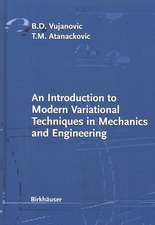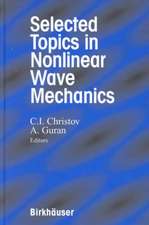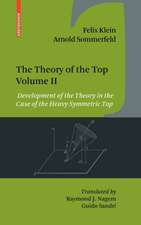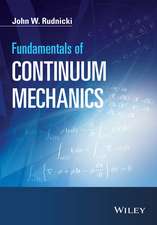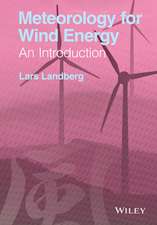Theory of Elasticity for Scientists and Engineers
Autor Teodor M. Atanackovic, Ardeshir Guranen Limba Engleză Hardback – 16 iun 2000
| Toate formatele și edițiile | Preț | Express |
|---|---|---|
| Paperback (1) | 645.14 lei 6-8 săpt. | |
| Birkhäuser Boston – 4 oct 2012 | 645.14 lei 6-8 săpt. | |
| Hardback (1) | 650.19 lei 6-8 săpt. | |
| Birkhäuser Boston – 16 iun 2000 | 650.19 lei 6-8 săpt. |
Preț: 650.19 lei
Preț vechi: 764.93 lei
-15% Nou
Puncte Express: 975
Preț estimativ în valută:
124.43€ • 129.43$ • 102.72£
124.43€ • 129.43$ • 102.72£
Carte tipărită la comandă
Livrare economică 14-28 aprilie
Preluare comenzi: 021 569.72.76
Specificații
ISBN-13: 9780817640729
ISBN-10: 081764072X
Pagini: 374
Ilustrații: XII, 374 p.
Dimensiuni: 155 x 235 x 24 mm
Greutate: 0.69 kg
Ediția:2000
Editura: Birkhäuser Boston
Colecția Birkhäuser
Locul publicării:Boston, MA, United States
ISBN-10: 081764072X
Pagini: 374
Ilustrații: XII, 374 p.
Dimensiuni: 155 x 235 x 24 mm
Greutate: 0.69 kg
Ediția:2000
Editura: Birkhäuser Boston
Colecția Birkhäuser
Locul publicării:Boston, MA, United States
Public țintă
ResearchCuprins
1 Analysis of Stress.- 1.1 Introduction.- 1.2 Stress vector. Cauchy’s theorem.- 1.3 Equilibrium equations in terms of stress components.- 1.4 The basic lemma of stress analysis.- 1.5 Equilibrium equations in coordinate systems.- 1.6 Transformation of stress matrix. Stress tensor.- 1.7 Extreme properties of principal stresses.- 1.8 Invariants of the stress tensor.- 1.9 Extreme values of shear stresses.- 1.10 Spherical and deviatoric part of stress tensor.- 1.11 Mohr’s stress circles.- 1.12 Plane state of stress.- 1.13 Normal and tangential stresses in the plane state of stress.- 1.14 Mohr’s circle for plane state of stress.- 1.15 Stresses at the outer surfaces of a body.- 1.16 Linear state of stress.- Problems.- 2 Analysis of Strain.- 2.1 Introduction.- 2.2 Measures of deformations. Strain tensor.- 2.3 Extension and shear angle for arbitrary directions.- 2.4 Infinitesimal rotation.- 2.5 Principal directions of strain tensor.- 2.6 Strain tensor in coordinate systems.- 2.7 Compatibility conditions for linear and nonlinear strain tensor.- 2.8 Plane state of strain.- 2.9 Linear strain tensor. Cubical dilatation.- 2.10 Measurement of strain. Strain gauges.- Problems.- 3 Hooke’s Law.- 3.1 Introduction.- 3.2 Transformation of the elasticity tensor by rotation of coordinate system.- 3.3 Anisotropic, orthotropic, and isotropic elastic body.- 3.4 Lamé constants. Modulus of elasticity. Poisson ratio.- 3.5 Influence of temperature on the stress-strain relation.- 3.6 Hooke’s law in cylindrical and spherical coordinate systems.- 3.7 Beltrami-Michell compatibility conditions.- 3.8 Finite deformations in linear state of stress.- Problems.- 4 Boundary Value Problems of Elasticity Theory.- 4.1 Introduction.- 4.2 Classification of problems.- 4.3 Lamé equations coordinatesystems.- 4.4 Uniqueness of solution.- 4.5 Assumptions about solution of equilibrium equations.- 4.6 Methods of solution.- 4.7 Saint-Venant principle.- Problems.- 5 Solutions for Some Problems of Elasticity Theory.- 5.1 Introduction.- 5.2 Heavy rod.- 5.3 Rotating rod.- 5.4 Spherical shell under inner and outer pressure.- 5.5 Torsion of a prismatic rod with an arbitrary cross-section.- 5.6 Torsion of a rod with variable circular cross-section.- 5.7 Bending by couples (pure bending).- 5.8 Bending of a rod by a terminal load.- 5.9 Elementary singular solutions.- 5.10 The Boussinesq problem.- 5.11 Tangential force on the elastic half space.- 5.12 Equilibrium of a circular cone.- 5.13 Thermal stresses in a sphere and in a cylinder.- 5.14 Plane harmonic waves in an elastic and thermoelastic body.- Problems.- 6 Plane State of Strain and Plane State of Stress.- 6.1 Introduction.- 6.2 Stress function method for the solution of plane problems.- 6.3 Some solutions of the plane problems.- 6.4 Complex variable method for plane problems.- Problems.- 7 Energy Method in Elasticity Theory.- 7.1 Introduction.- 7.2 Work and inner energy.- 7.3 Betti’s theorem.- 7.4 Maxwell’s theorem.- 7.5 Principle of virtual work.- 7.6 Principle of virtual displacements.- 7.7 Principle of virtual forces.- 7.8 Minimum of potential and complementary energy theorems.- 7.9 Castigliano’s theorems.- 7.10 Hu-Washizy and Reissner variational principles.- Problems.- 8 Elementary Theory of Plates.- 8.1 Introduction.- 8.2 Basic equations of von Kármán’s theory of plates.- 8.3 Boundary conditions.- 8.4 Small deformations: An example.- 8.5 The influence of shear stresses: Reisner-Mindlin theory.- Problems.- 9 Pressure Between Two Bodies in Contact.- 9.1 Introduction.- 9.2 Hertz’s Problem and ItsSolution.- 9.3 Examples of Contact Stresses.- 9.4 Theory of Elastic Impact.- Problems.- 10 Elastic Stability.- 10.1 Introduction.- 10.2 Definitions of stability.- 10.3 Basic theorems of the dynamic method.- 10.4 Examples.- Problems.- References.
Recenzii
"…the layout is pleasant, the figures are well drawn; and equations, numbered separately by chapter, are appropriately separated and easily read. The book succeeds in its stated aim of providing a basic, yet sufficiently comprehensive text in elasticity. It is considered very suitable as a senior course for students who have either a major interest or sufficient curiosity in the basics of continuum mechanics."
---Applied Mechanics Review
---Applied Mechanics Review



